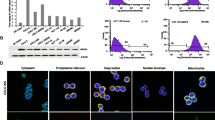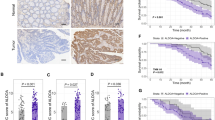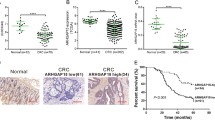Abstract
There was no literature reporting the relationship between AKAP13 and colorectal carcinoma. This study is aim to investigate the expression and role of AKAP13 in human colorectal cancers. This study investigated 94 pair-matched human colorectal cancers and adjacent normal mucosa, as well as 36 adenomas, of which mRNA expression of AKAP13 was detected by relative Quantitative-Real-Time RT-PCR and protein expression by immunohistochemical staining. AKAP13 gene was upregulated in colorectal cancer group by 2.259 times compared to control group without significant difference (P = 0.081), and no expression was detected in adenoma by RT-PCR. The positive expression rate of AKAP13 protein in colorectal carcinoma (52.3%) was significantly higher than those in adenoma (9.1%) and normal tissue (34.7%) (P = 0.006) by immunohistochemical staining. Either the mRNA or protein expressions of AKAP13 were correlated with histological types and differentiation grade (P < 0.05). Our results suggest AKAP13 protein may be related to the carcinogenesis of human colorectal cancer. However, more deeply and larger scale research are required to prove the correlation.

Similar content being viewed by others
References
National Comprehensive Cancer Network (2008) NCCN clinical practice guideline in oncology™. Colon cancer V.1.2008. http://www.nccn.org/professionals/physician_gls/PDF/colon.pdf. Accessed on 15 Oct 2008
Vogelstein B, Kinzler KW (1993) The multistep nature of cancer. Trends Genet 9:138–141
Paul J (2006) A-kinase anchor protein 13. online mendelian inheritance in man. http://www.ncbi.nlm.nih.gov/entrez/dispomim.cgi?id=604686 updated: 3/13/2006. Accessed on 18 Dec 2007
Carr DW, Stofko-Hahn RE, Fraser ID, Bishop SM, Acott TS, Brennan RG, Scott JD (1991) Interaction of the regulatory subunit (RII) of cAMP-dependent protein kinase with RII-anchoring proteins occurs through an amphipathic helix binding motif. J Biol Chem 266:14188–14192
Diviani D, Abuin L, Cotecchia S, Pansier L (2004) Anchoring of both PKA and 14–3-3 inhibits the Rho-GEF activity of the AKAP-Lbc signaling complex. EMBO J 23:2811–2820
Feliciello A, Gottesman ME, Avvedimento EV (2001) The biological functions of A-kinase anchor proteins. J Mol Biol 308:99–114
Diviani D, Soderling J, Scott JD (2001) AKAP-Lbc anchors protein kinase A and nucleates Galpha 12-selective Rho-mediated stress fiber formation. J Biol Chem 276:44247–44257
Sahai E, Marshall CJ (2002) RHO-GTPases and cancer. Nat Rev Cancer 2:133–142
Ridley AJ (2001) Rho GTPases and cell migration. J Cell Sci 114:2713–2722
Bhowmick NA, Ghiassi M, Bakin A, Aakre M, Lundquist CA, Engel ME, Arteaga CL, Moses HL (2001) Transforming growth factor-beta1 mediates epithelial to mesenchymal transdifferentiation through a RhoA-dependent mechanism. Mol Biol Cell 12:27–36
Worthylake RA, Lemoine S, Watson JM, Burridge K (2001) RhoA is required for monocyte tail retraction during transendothelial migration. J Cell Biol 154:147–160
Etienne-Manneville S, Hall A (2002) Rho GTPases in cell biology. Nature 420:629–635
Fritz G, Just I, Kaina B (1999) Rho GTPases are over-expressed in human tumors. Int J Cancer 81:682–687
Wirtenberger M, Tchatchou S, Hemminki K, Klaes R, Schmutzler RK, Bermejo JL, Chen B, Wappenschmidt B, Meindl A, Bartram CR, Burwinkel B (2006) Association of genetic variants in the Rho guanine nucleotide exchange factor AKAP13 with familial breast cancer. Carcinogenesis 27:593–598
Wirtenberger M, Schmutzhard J, Hemminki K, Meindl A, Sutter C, Schmutzler RK, Wappenschmidt B, Kiechle M, Arnold N, Weber BH, Niederacher D, Bartram CR, Burwinkel B (2007) The functional genetic variant Ile646Val located in the kinase binding domain of the A-kinase anchoring protein 10 is associated with familial breast cancer. Carcinogenesis 28:423–426
Lewis TE, Milam TD, Klingler DW, Rao PS, Jaggi M, Smith DJ, Hemstreet GP, Balaji KC (2005) Tissue transglutaminase interacts with protein kinase A anchor protein 13 in prostate cancer. Urol Oncol 23:407–412
Sterpetti P, Marucci L, Candelaresi C, Toksoz D, Alpini G, Ugili L, Baroni GS, Macarri G, Benedetti A (2006) Cell proliferation and drug resistance in hepatocellular carcinoma are modulated by Rho GTPase signals. Am J Physiol Gastrointest Liver Physiol 290:G624–G632
Jass JR, Sobin LH (1989) Histological typing of intestinal tumors. International histological classifications of tumors, 2nd edn. Springer, Berlin
Rober JCS (2006) Colonic cancer. In: Robin KSP (ed) A companion to specialist surgical practice-colorectal surgery, 3rd edn. Elsevier Saunders Publication, Philadelphia, p 59
Mygind T, Birkelund S, Birkebaek NH, Østergaard L, Jensen JS, Christiansen G (2002) Determination of PCR efficiency in chelex-100 purified clinical samples and comparison of real-time quantitative PCR and conventional PCR for detection of Chlamydia pneumoinae. BMC Microbiol 2:17
Anderson KM, Cheung PH, Kell MD (1997) Rapid generation of homologous internal standards and evaluation of data for quantitation of messenger RNA by competitive polymerase chain reaction. J Pharmacol Toxicol Methods 38:133–140
Yang L, Zhou ZG, Luo HZ, Zhou B, Xia QJ, Tian C (2006) Quantitative analysis of PPARdelta mRNA by real-time RT-PCR in 86 rectal cancer tissues. Eur J Surg Oncol 32:181–185
Wu CC, Shyu RY, Chou JM, Jao SW, Chao PC, Kang JC, Wu ST, Huang SL, Jiang SY (2006) RARRES1 expression is significantly related to tumour differentiation and staging in colorectal adenocarcinoma. Eur J Cancer 42:557–565
Pfaffl MW, Horgan GW, Dempfle L (2002) Relative expression software tool (REST) real-time PCR. Nucleic Acids Res 30:e36
Wong W, Scott JD (2004) AKAP signalling complexes: focal points in space and time. Nat Rev Mol Cell Biol 5:959–970
Chen S, Crawford M, Day RM, Briones VR, Leader JE, Jose PA, Lechleider RJ (2006) RhoA modulates Smad signaling during transforming growth factor-β-induced smooth muscle differentiation. J Biol Chem 281:1765–1770
Wei L, Zhou W, Croissant JD, Johansen FE, Prywes R, Balasubramanyam A, Schwartz RJ (1998) RhoA signaling via serum response factor plays an obligatory role in myogenic differentiation. J Biol Chem 273:30287–30294
Castellani L, Salvati E, Alemà S, Falcone G (2006) Fine regulation of RhoA and Rock is required for skeletal muscle differentiation. J Biol Chem 281:15249–15257
Wang G, Woods A, Sabari S, Pagnotta L, Stanton LA, Beier F (2004) RhoA/ROCK signaling suppresses hypertrophic chondrocyte differentiation. J Biol Chem 279:13205–13214
Chen TC, Hinton DR, Zidovetzki R, Hofman FM (1998) Upregulation of the cAMP/PKA pathway inhibits proliferation, induces differentiation, and leads to apoptosis in malignant gliomas. Lab Invest 78:165–174
Cross TG, Scheel-Toellner D, Henriquez NV, Deacon E, Salmon M, Lord JM (2000) Serine/threonine protein kinases and apoptosis. Exp Cell Res 256:34–41
Taskén K, Skålhegg BS, Taskén KA, Solberg R, Knutsen HK, Levy FO, Sandberg M, Orstavik S, Larsen T, Johansen AK, Vang T, Schrader HP, Reinton NT, Torgersen KM, Hansson V, Jahnsen T (1997) Structure, function, and regulation of human cAMP-dependent protein kinases. Adv Second Messenger Phosphoprotein Res 31:191–204
Acknowledgments
This study was granted by National Natural Science Foundation of China (No. 30600591) and China Medical Board of New York Inc. (No. CMB 96636). The authors thank Professor Kai-Xuan Yang (West China Second Hospital, Sichuan University) for her professional pathologic technology support.
Conflict of interest statement
The authors declare that they have no conflict of interest related to the publication of this manuscript.
Author information
Authors and Affiliations
Corresponding author
Rights and permissions
About this article
Cite this article
Hu, JK., Wang, L., Li, Y. et al. The mRNA and protein expression of A-kinase anchor proteins 13 in human colorectal cancer. Clin Exp Med 10, 41–49 (2010). https://doi.org/10.1007/s10238-009-0065-x
Received:
Accepted:
Published:
Issue Date:
DOI: https://doi.org/10.1007/s10238-009-0065-x




